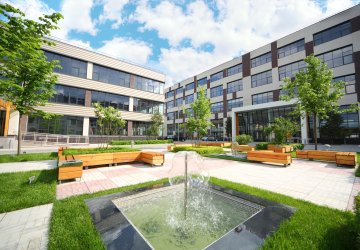Many organizations are wondering what the post-pandemic office will look like and how they can best prepare. In this blog, I will discuss some characteristics that we at Planon envision for the office of the future – not just “post-pandemic” but also in five or 10 years' time. And we are happy to note that many of these ideas have already been introduced into our newly opened Innovation Campus.
1. More space per employee
Overflowing desks? Forget it. In the future, there will be no more desks with three or four drawers, no cabinets and very few things in general that might make the workplace look cluttered or disorganized. Employees will work at desks that can be flexibly reserved rather than being allocated to a single person. Above all, the office will have to be a light, spacious area, and ideally much more attractive to an employee than the space they work at within their home.
With fewer people predicted to be in the office at any given time, companies will be able to allocate space differently. The details of how that space will be arranged will largely depend on the nature of the company, its employees, and the work they are going to do in the office – as this article by McKinsey shows. Organizations must reimagine their use of space, according to McKinsey, to see how that space influences collaboration, productivity, corporate culture and the entire work experience. However, in my opinion, comfort will be the main theme in these workplaces.
2. Everything is connected
In recent years, sensors have become cheaper and smaller than ever. Machine learning and artificial intelligence can be applied to obtain more and more insights and check processes with the data that sensors generate. The office of the future will have numerous sensors connected to multiple systems within the building. A centralized software platform will act as the building’s brain, transferring information to other devices, facility teams or building users. Desk height and climate will automatically adapt to personal preferences. If rooms or workplaces are not used, climate control will take a step down, thus saving energy. Cleaning routes will be adapted, as only rooms that have been used require daily cleaning. Even catering can adapt based on data about the number of people that came into the office any given day. In short: building services that flexibly adapt to the actual demand.
3. Indoors or outdoors
In 2023, company buildings in the Netherlands must have at least energy label C, but eventually they must be totally energy neutral – a development that is of course not limited to the Netherlands alone.
Architects and builders will need to make sustainable, environmentally-friendly choices in their designs. Not only for compliance purposes, but also because user requirements change. Therefore, the office of the future will have many eco-friendly features – including lots of green – and the boundaries between indoors and outdoors will become blurred. Glass walls will keep the building warm if necessary or keep out extreme heat. Perhaps walls will even have the potential to 'disappear', creating an office that can be as open and fresh as possible. Sunlight is not only converted into energy by solar panels, but people use it to recharge and stay inspired as well! At our Innovation Campus we have created an outside vegetable garden with a big table in the middle – we call it Meeting Room 99. Imagine having a meeting or a talk while harvesting some strawberries!
With the employer of the future, you will go home healthier than you arrived that morning. The work environment plays an important role in that.
4. From possession to use
It will be totally normal for companies to rent workspace to smaller businesses or contractors who will then be able to decide on a daily or weekly basis where they go that day. Whether that is for meetings, productive work or creative inspiration. Organizations will share the space they have with organizations that have none. In this way, the office will become an ecosystem with room for start-ups and students to participate.
This is not just practical and economical. Because workplaces will be much more flexible and offices attract a much wider audience, cross-pollination and innovation will increase. Employees who come to the office will continuously meet people from other organizations and learn from them.
5. Social and creative
The entire office of the future will be designed as a place that encourages social interaction and creativity. You want to be there. It is a pleasant place that will outclass your home office. An old-fashioned closed office or the classic cubicle will certainly not do that and is, therefore, not an option in the office of the future.
In the years to come, I believe that employees will demand freedom and flexibility, probably supported by policy makers. More freedom, less traffic on the road, lower exhaust emissions: everyone sees the advantages of a flexible presence. And when employees do come to the office, they will find a nurturing space that helps them complete their tasks at hand, and quite simply, a space where they can have fun and feel good while being there. We can check emails and do video meetings at home, but really getting to know, inspire and collaborate with each other? That is what the office is for. And it must be designed accordingly.

